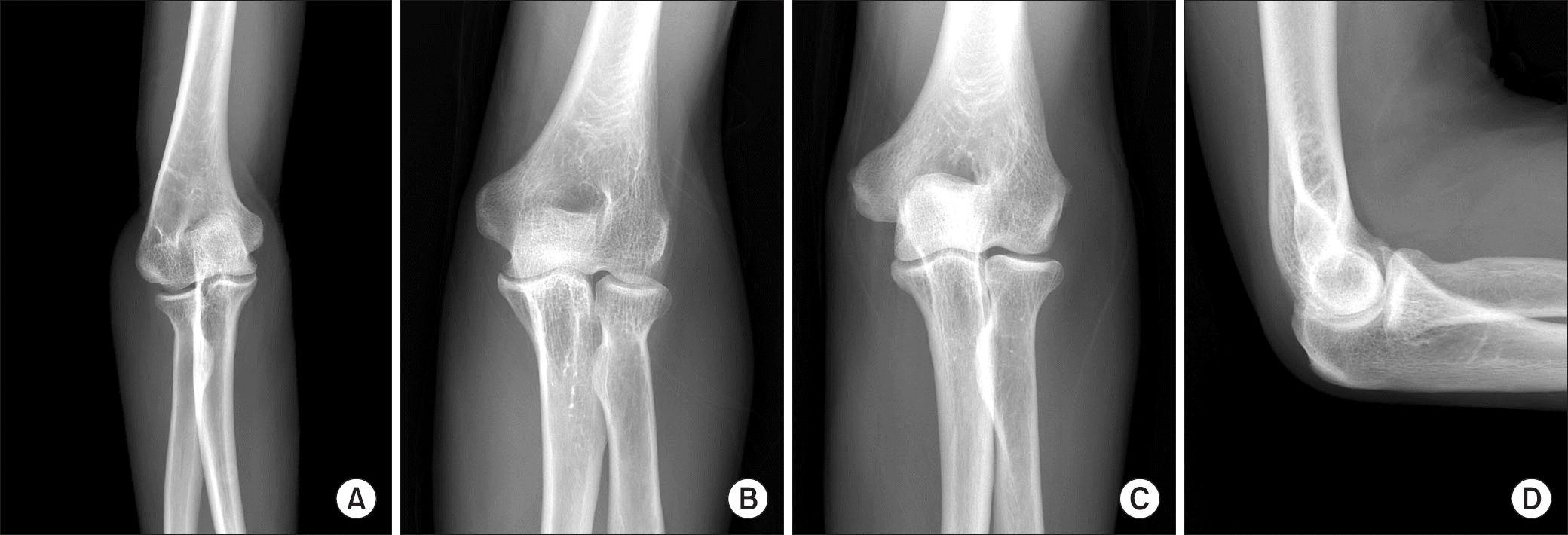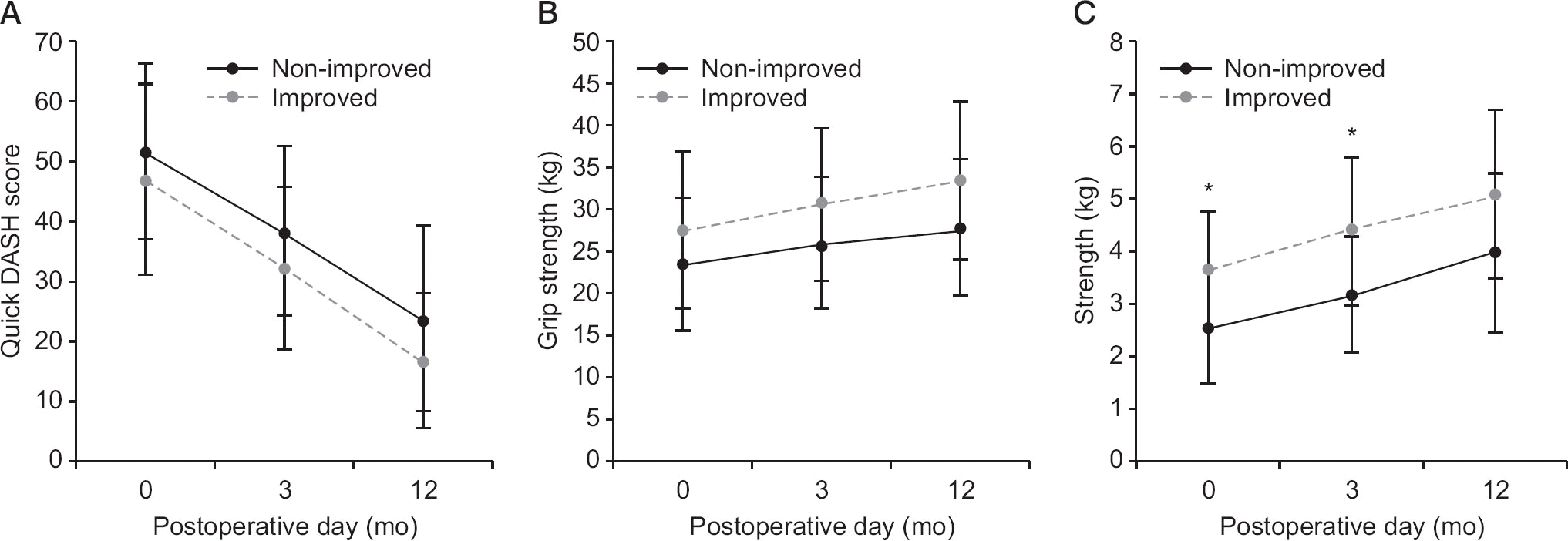Abstract
Purpose
Moderate to severe cubital tunnel syndrome usually requires surgical treatment. Most surgical outcomes are evaluated 6 months after the procedure; however, subjective symptoms begin to show improvement much earlier. In this study, we explored whether patients who experience early improvement of subjective symptoms have different clinical characteristics and surgical outcomes than those without early improvement.
Materials and Methods
Between January 2012 and February 2015, 36 surgical cases of moderate- to severe-stage cubital tunnel syndrome (modified McGowan grade IIA, IIB, or III) were included. Nineteen patients (15 males and 4 females with a mean age of 54.3±12.0 years) reported subjective symptom improvements within 14 days postoperatively. Seventeen patients (15 males and 2 females with a mean age of 53.4±11.9 years) did not report any early symptom improvements. Clinical characteristics—hand dominance, sex, smoking history, type of surgery, age, symptom duration, elbow range of motion, grip strength, key pinch strength, 2 point discrimination, pain, quick disabilities of the arm, shoulder and hand (DASH) score, and modified McGowan grade—were analyzed retrospectively using a Mann-Whitney test or chi square test. Surgical outcomes were measured at postoperative 3 and 12 months using repeated-measures ANOVA, and Wilson and Krout criteria were analyzed using a chi-square test.
Results
There was a difference in key pinch strength (p<0.001) between the groups. At postoperative 12 months, Wilson and Krout criteria (p=0.029) were associated with early improvement of subjective symptoms. The subjects’ quick DASH scores and grip strengths improved over time, but no difference was observed between the groups.
Go to : 
REFERENCES
1. Mowlavi A, Andrews K, Lille S, Verhulst S, Zook EG, Milner S. The management of cubital tunnel syndrome: a meta-analysis of clinical studies. Plast Reconstr Surg. 2000; 106:327–34.

2. Latinovic R, Gulliford MC, Hughes RA. Incidence of common compressive neuropathies in primary care. J Neurol Neurosurg Psychiatr. 2006; 77:263–5.

3. Dellon AL. Review of treatment results for ulnar nerve entrapment at the elbow. J Hand Surg Am. 1989; 14:688–700.
4. Goldberg BJ, Light TR, Blair SJ. Ulnar neuropathy at the elbow: results of medial epicondylectomy. J Hand Surg Am. 1989; 14:182–8.

5. Svernlöv B, Larsson M, Rehn K, Adolfsson L. Conservative treatment of the cubital tunnel syndrome. J Hand Surg Eur Vol. 2009; 34:201–7.

6. Catalano LW 3rd, Barron OA. Anterior subcutaneous transposition of the ulnar nerve. Hand Clin. 2007; 23:339–44.

7. Dellon AL. Techniques for successful management of ulnar nerve entrapment at the elbow. Neurosurg Clin N Am. 1991; 2:57–73.

8. Kleinman WB, Bishop AT. Anterior intramuscular transposition of the ulnar nerve. J Hand Surg Am. 1989; 14:972–9.

9. Kim KW, Lee HJ, Rhee SH, Baek GH. Minimal epicondylecto-my improves neurologic deficits in moderate to severe cubital tunnel syndrome. Clin Orthop Relat Res. 2012; 470:1405–13.

10. Nabhan A, Ahlhelm F, Kelm J, Reith W, Schwerdtfeger K, Steudel WI. Simple decompression or subcutaneous anterior transposition of the ulnar nerve for cubital tunnel syndrome. J Hand Surg Br. 2005; 30:521–4.

11. Mitsionis GI, Manoudis GN, Paschos NK, Korompilias AV, Beris AE. Comparative study of surgical treatment of ulnar nerve compression at the elbow. J Shoulder Elbow Surg. 2010; 19:513–9.

12. Macadam SA, Bezuhly M, Lefaivre KA. Outcomes measures used to assess results after surgery for cubital tunnel syndrome: a systematic review of the literature. J Hand Surg Am. 2009; 34:1482–91.e5.

13. Lascar T, Laulan J. Cubital tunnel syndrome: a retrospective review of 53 anterior subcutaneous transpositions. J Hand Surg Br. 2000; 25:453–6.

14. Hoffmann R, Siemionow M. The endoscopic management of cubital tunnel syndrome. J Hand Surg Br. 2006; 31:23–9.

15. Kawanishi Y, Miyake J, Omori S, Murase T, Shimada K. The association between cubital tunnel morphology and ulnar neuropathy in patients with elbow osteoarthritis. J Shoulder Elbow Surg. 2014; 23:938–45.

16. Novak CB, Lee GW, Mackinnon SE, Lay L. Provocative testing for cubital tunnel syndrome. J Hand Surg Am. 1994; 19:817–20.

17. Oh SJ. Clinical electromyography: nerve conduction studies. 2003. 3rd ed. Philadelphia: Lippincott Williams & Wilkins;p. 105.
18. Mathiowetz V, Rennells C, Donahoe L. Effect of elbow position on grip and key pinch strength. J Hand Surg Am. 1985; 10:694–7.

19. Wilson DH, Krout R. Surgery of ulnar neuropathy at the elbow: 16 cases treated by decompression without transposition. Technical note. J Neurosurg. 1973; 38:780–5.
20. Köse KC, Bilgin S, Cebesoy O, et al. Clinical results versus subjective improvement with anterior transposition in cubital tunnel syndrome. Adv Ther. 2007; 24:996–1005.

21. Assmus H, Antoniadis G, Bischoff C. . Cubital tunnel syndrome: a review and management guidelines. Cent Eur Neurosurg. 2011; 72:90–8.
22. Nathan PA, Keniston RC, Meadows KD. Outcome study of ulnar nerve compression at the elbow treated with simple decompression and an early programme of physical therapy. J Hand Surg Br. 1995; 20:628–37.

23. Goldfarb CA, Sutter MM, Martens EJ, Manske PR. Incidence of re-operation and subjective outcome following in situ decompression of the ulnar nerve at the cubital tunnel. J Hand Surg Eur Vol. 2009; 34:379–83.

24. Ogata K, Manske PR, Lesker PA. The effect of surgical dissection on regional blood flow to the ulnar nerve in the cubital tunnel. Clin Orthop Relat Res. 1985; 193:195–8.

25. Gaspar MP, Jacoby SM, Osterman AL, Kane PM. Risk factors predicting revision surgery after medial epicondylectomy for primary cubital tunnel syndrome. J Shoulder Elbow Surg. 2016; 25:681–7.

26. Seradge H, Owen W. Cubital tunnel release with medial epi-condylectomy factors influencing the outcome. J Hand Surg Am. 1998; 23:483–91.

27. Shi Q, MacDermid JC, Santaguida PL, Kyu HH. Predictors of surgical outcomes following anterior transposition of ulnar nerve for cubital tunnel syndrome: a systematic review. J Hand Surg Am. 2011; 36:e1–6.

28. Bartels RH, Verhagen WI, van der Wilt GJ, Meulstee J, van Rossum LG, Grotenhuis JA. Prospective randomized controlled study comparing simple decompression versus anterior subcutaneous transposition for idiopathic neuropathy of the ulnar nerve at the elbow: part 1. Neurosurgery. 2005; 56:522–30.

Go to : 
 | Figure 1Radiologically excluded cases (A, B) and included case (C, D) are presented. (A) An anteroposterior radiograph of a 39-year-old male with post traumatic cubitus varus deformity. (B) In an anteroposterior radiograph of a 55-year-old male, there are medial osteophytes on the humerus and the ulna. (C, D) A small osteophytes are identified at the coronoid process and olecranon of a 62-year-old male. There is no medial osteophyte on the humerus and ulna. |
 | Figure 2Quick disabilities of the arm, shoulder and hand (quick DASH) scores (A), grip strength (B), and pinch strength (C) are shown. *p<0.017; error bars=1 standard deviation. |
Table 1
Patient Demographics and Clinical Characteristics at Preoperative Status
Table 2
Preoperative Modified McGowan Grade*
| McGowan grading | Non-improved | Improved |
|---|---|---|
| IIa | 2 | 6 |
| IIb | 12 | 9 |
| III | 3 | 4 |
Table 3
Postoperative Wilson and Krout's Criteria*
Table 4
Quick DASH Score, Grip Strength and Pinch Strengths at the Preoperative State, 3 Months and 12 Months after the Surgery
| Function | Preoperative | 3 months after the surgery | 12 months after the surgery | |||
|---|---|---|---|---|---|---|
| Non-improved | Improved | Non-improved | Improved | Non-improved | Improved | |
| Quick DASH score* | 51.5±14.5 | 46.9±15.9 | 38.4±13.9 | 32.3±13.4 | 24.0±15.4 | 17.0±11.1 |
| Grip strength (kg)† | 23.6±7.9 | 27.6±9.3 | 25.9±8.0 | 30.8±9.2 | 27.9±8.1 | 33.5±9.4 |
| Pinch strength (kg)‡ | 2.6±1.1 | 3.7±1.4 | 3.2±1.1 | 4.4±1.4 | 4.0±1.5 | 5.1±1.6 |




 PDF
PDF ePub
ePub Citation
Citation Print
Print


 XML Download
XML Download